Warning: Trying to access array offset on value of type null in /home/b4ey4rbk3gtb/domains/lakesidelabair.org/html/wp-content/themes/LakesideLabAIR17/single.php on line 19
(A brief history of diatoms! As adapted through conversation with Matt Julius,
a Lakeside affiliate & professor of Biology and Science History at St. Cloud State University)
What happens behind Lakeside’s stone gates? What unfolds along the shoreline in Little Miller’s Bay? What has transpired along snaking trails deep in the prairielands?
As a local, I only ever seemed to hear the metaphorical bass of a party happening somewhere beyond the boundaries of NW Iowa’s notable field station. My peers and I knew its name; we had no grasp of its function, history, or feeling.
Mysterious yet integrated, Lakeside Lab is but another (metaphorical) bay in a lake that is the Lakes Area community. While less frequently explored by our community’s majority, the seaweed grows thick and sways in the waves. Like fish, many take joy and shelter in its rich ecosystem. It has been this way for decades, and with proper stewardship, it will be this way for decades to come.
From one local to another, here is the quick and dirty about a limb you didn’t know you had:
One: Lakeside Lab is a local field station (or a living/outdoor library) that is best known for specializing in diatomy (or the study of algae). Iowa’s three regent universities – the University of Iowa, Iowa State University, and the University of Northern Iowa – have funded the field station since it was first established in 1904. Far from major universities farther south in Iowa, Lakeside Lab represents a direct local line to higher education.
Two: Lakeside Lab, nestled in the popular Miller’s Bay on West Lake Okoboji, has a global reach as it was THE international hub of diatom research before algae was recognized as a) important (i.e. a critical foundation of lake ecosystems, oxygen levels, etc.) and b) cool (i.e. withholding incredible potential for future sustainable alternatives).
Three: Now that algae research points to new products, food sources, and predictive indicators of future climate patterns – especially in an age of anticipation and problem solving – climate research continues to cite science conducted in Dickinson County, Iowa. “Climate change investigations can all be two orders of separation traced back to Lakeside Lab.” (Julius).
Cool, right? Let’s backtrack. Here’s some historical trivia to share on your next tour around the Lakes Area:
In today’s climate crisis, the need for nature-based solutions puts algae in the spotlight. While currently valued as a trove of possibilities – dyes, surgical aids, food sources, energy sources, and so on – it was not always considered important. Algae were, more specifically, considered “lesser organisms.”
The plight for algae equality aside, “lesser people” were once assigned work on “lesser organisms.” In the 1940’s, for example, what do you do with a bright woman in science? “My God, we can’t let her study animals! We can’t let her study vascular plants!, those are important. Go study algae. What do we do with somebody who has a different sexual preference? We can’t let them study mammals, for God’s sake!… make them study algae.” (Julius). Happenstance funneled these algae-minded individuals to Northwest Iowa.
So be it. Bring in the misfits: a group of social outsiders gather around microscopes and bodies of water. They stick together, develop strong social bonds, and exchange their knowledge openly. Traditions take root on the banks of West Lake Okoboji. The Mothers and Fathers of algae made Lakeside their place of research, which was only the beginning.
Interest in algae increases, and aspiring scientists everywhere catch wind of a small set of experts looking through microscopes in Northwest Iowa. Since the 60’s, scientists interested in diatoms made a great pilgrimage to Wahpeton, Iowa, from all over the world to learn from diatom legends. “There are probably more diatom species described in the second half of the 20th century from Dickinson County, Iowa, than most places on the planet.” (Julius).
Not only did a jump in public literature center our small lake community in global scientific conversations, it also attracted new perspectives to an otherwise lake-centered, Midwest-Nice community. Where else could offer world-class education in a small-town, biodiversity-rich learning environment?
Today, the legacy of legendary scientists, the loyalty of a band of misfits, and a nuanced understanding of an ecologically rich place, all live on at Lakeside Lab. While some still study diatoms, others flock to Lakeside to understand the Lakes Area from other angles: birds, soil, plant life, and so on. People who love Lakeside return again and again, and they pass their stories and experiences on to the next bout of students.
A single pebble makes a ripple. Lakeside’s first founders’ impact ripples still today. With proper stewardship, we can toss another pebble and continue a legacy.
By Josie Hoien




